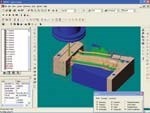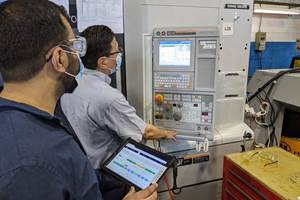Advanced CNC Programming Methods Help Manufacturer Meet Tight Deadlines
Nearly every aircraft is prone to tiny cracks that begin at holes used to insert fasteners and that, if not addressed, can eventually migrate from one hole to the next and cause structural failures.
Nearly every aircraft is prone to tiny cracks that begin at holes used to insert fasteners and that, if not addressed, can eventually migrate from one hole to the next and cause structural failures.
Split sleeve cold expansion, from Fatigue Technology (Seattle, Washington) is a process for increasing the fatigue life of holes in metal structures. The process radically expands a hole, creates a zone of residual compressive stresses around the hole and protects it from the effects of cyclic stresses. This is done using a tapered mandrel fitted with a lubricated sleeve and drawing the mandrel/sleeve combination through the hole using a hydraulic puller.
Most of the Fatigue Technology's production consists of cylindrical parts, so the company has focused on obtaining the latest turning technology from around the world. It has five nine-axis Index G3000 mill-turn centers with dual spindles, dual turrets, a milling head and a rotary axis on each spindle that precisely locates a milled workpiece. The company also has two Star six- and seven-axis lathes with a sliding headstock that feeds the work through the machine to produce very long parts. It has many other conventional four-axis and two-axis turning centers.
This advanced complement of metalworking machinery provides the potential for high levels of productivity and accuracy, but it also creates programming challenges. Controlling all of those axes is a major task, but optimizing the complex capabilities of these machines and simplifying the process of accessing their capabilities is even more difficult.
The company also faces extremely tight time constraints. For example, Fatigue Technology's contract with Boeing specifies that 80 percent of jobs must be completed within 24 hours of the time the order is received.
To meet these challenges, Bob Renfrow, manufacturing manager at Fatigue Technology, selected Esprit CAM from DP Technology (Camarillo, California) as the company's CNC programming software.
The programming process begins when the design engineer sends an approved solid model in the Parasolid format. The CNC programmer defines the boundaries of the finished part and selects which operations will be performed while the part is held in the front and back spindles, making it possible to perform all machining operations in a single setup. The program is then automatically transferred from one spindle to the other. Operations are also divided between turrets, so that if 1 inch of metal needs to be removed, the two turrets are placed close to each other. They split the cut up so it can be performed in half the time that would be required by a single turret machine. The CAM system can control spindle speed in either constant rpm or constant sfm mode.
"Esprit will automatically determine the best way to perform the individual operations based on the characteristics of the tool," Mr. Renfrow says. "Then it will calculate the cycle times for each operation and display them in a bar chart. The programmer can then add ‘Sync' and ‘Wait' codes to synchronize the machining operations, and the bar chart immediately displays the updated cycle times. The programmer can also drag and drop operations from one turret or spindle to another and click on the appropriate place in the chart to view the actual G-codes for a specific operation and make edits on the fly.
"When the programmer feels that the program is ready, he produces a part on the computer and watches as the CAM software simulates every machine movement including tailstock operations, bar feeds and part exchanges. Finally, he zooms in on a computer image of the actual geometry that will be produced by the program in order to be sure it will meet the customer's requirements. The programmer can see exactly where he has missed undercuts and dimensions and can go back to make the necessary corrections."
Fatigue Technology programmers also take advantage of Esprit's tooling system, which uses ANSI/ISO standard coding to simplify the process of defining cutting tools. These standard tools, along with custom tools created by the company's programmers, can be selected and inserted into a program. The correct inserts, holders and turrets are shown during the machining simulation and appear on a setup sheet that is automatically produced with each program. The program, along with the setup sheet, is released to the shop floor electronically.
Mr. Renfrow has gone one step further to speed programming of families of parts that are produced on a regular basis. He writes a macro that defines the basic operations used to produce the part and that accepts the variables that define the final dimensions of the part from a SQL database. The macro is carefully optimized and tuned to minimize cycle times and ensure that everything runs correctly. Programmers need only enter the actual dimensions of the part into a spreadsheet in order to generate a new program in a matter of a minute or two.
"Using these methods, we can produce very complicated CNC programs in a very short period of time, then verify them on the computer to make sure they are correct," Mr. Renfrow says. "Everything is then delivered electronically to the operator on the shop floor so that in a matter of a few hours, we can go from design drawings to cutting chips.
"When you have a Boeing 747 sitting idle on a runway somewhere, waiting for one of our tools, every second counts."
Related Content
Best Practices: Machining Difficult Materials
Cutting hardened steel, titanium and other difficult materials requires picking the right tools, eliminating spindle runout and relying on best practices to achieve tight part tolerances.
Read MoreToolpath-Level Machine Monitoring Improves Aerospace OEE
Machine monitoring software that records historical efficiency to the toolpath level helped aerospace manufacturer Leesta improve its OEE by ten points.
Read More10 Tips for Titanium
Simple process considerations can increase your productivity in milling titanium alloys.
Read More10 Things to Know About Creep-Feed Grinding
Because of the high material removal rate creep-feed grinding can deliver in challenging materials, grinding might not be just the last step in the process—it might be the process.
Read MoreRead Next
3 Mistakes That Cause CNC Programs to Fail
Despite enhancements to manufacturing technology, there are still issues today that can cause programs to fail. These failures can cause lost time, scrapped parts, damaged machines and even injured operators.
Read MoreThe Cut Scene: The Finer Details of Large-Format Machining
Small details and features can have an outsized impact on large parts, such as Barbco’s collapsible utility drill head.
Read More



























